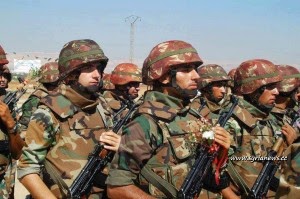 Tony Cartalucci
Tony Cartalucci
Activist Post
Since 2011, the Syrian Arab Army (SAA) has waged a relentless war within Syrian territory against what it has said from the very beginning was an invasion of heavily armed, foreign-backed sectarian extremists. In retrospect, the transparently ludicrous nature of articles like the Guardian’s “Syria’s rebels unite to oust Assad and push for democracy” is self-evident. The article would lay out Syria’s claims side by side with the West’s narrative by stating:
In one of the fiercest clashes of the insurrection, Syrian troops finally took control of the town of Rastan after five days of intense fighting with army defectors who sided with protesters. Syrian authorities said they were fighting armed terrorist gangs.
In retrospect, and upon examining the obvious lay of Syria’s battlefields today, it is clear Syrian authorities were right.
Shortly after NATO carried out successful “regime change” in Libya in 2011 under the false pretext of a “humanitarian intervention,” sectarian-driven mercenaries it armed, funded, and provided air cover for in Libya began steadily streaming into Syria via its northern border with NATO-member Turkey.
Terrorists from the US State Department designated terrorist organization, the Libyan Islamic Fighting Group (LIFG) officially made contact with terrorists fighting in Syria to offer them weapons, cash, training, and fighters. The London Telegraph would report in their article, “Leading Libyan Islamist met Free Syrian Army opposition group,” that:
The meetings came as a sign of a growing ties between Libya’s fledgling government and the Syrian opposition. The Daily Telegraph on Saturday revealed that the new Libyan authorities had offered money and weapons to the growing insurgency against Bashar al-Assad.
Mr Belhaj also discussed sending Libyan fighters to train troops, the source said.
Indeed, at the highest levels, even as far back as 2011-2012, the so-called “moderate rebels” were entwined with Al Qaeda, vindicating the Syrian government’s statements regarding its struggle against foreign-backed terrorism, not a “pro-democracy uprising.”
Today, the West has expunged all rhetoric regarding “pro-democracy,” with sectarian extremism clearly driving militancy across both sides of Syria’s borders with Lebanon and Iraq. Instead, the West has been resigned to attempts in differentiating between groups like Al Qaeda’s al Nusra franchise and its Islamic State (ISIS) counterparts – claiming the latter must be addressed more urgently, even at the cost of cooperating with the former – yet another US State Department designated terrorist organization.
And while the fierce fighting in Syria may have began in 2011, the war on foreign-backed sectarian extremism began a generation ago. From 1976 to 1982, Syrian President Bashar al Assad’s father, Hafez al-Assad, waged war on the heavily militarized Muslim Brotherhood. Upon breaking the back of the organization in Syria, it fled and was later reconstituted by the United States and Saudi Arabia into what would become Al Qaeda in the mountains of Afghanistan to fight the Soviet Union.
In the US Army’s West Point Combating Terrorism Center (CTC) 2008 report titled, “Bombers, Bank Accounts and Bleedout: al-Qa’ida’s Road In and Out of Iraq,” it stated unequivocally that (emphasis added):
During the first half of the 1980s the role of foreign fighters in Afghanistan was negligible and was largely un‐noticed by outside observers. The flow of volunteers from the Arab heartland countries was just a trickle in the early 1980s, though there were more significant links between the mujahidin and Central Asian Muslims—especially Tajiks, Uzbeks, and Kazakhs. Individuals like the above‐mentioned Abu’l‐Walid were recruited in the early years via ad hoc outreach campaigns initiated from within Afghanistan, but by 1984, the resources being poured into the conflict by other countries—especially Saudi Arabia and the United States—had become much greater, as had the effectiveness and sophistication of the recruitment efforts. Only then did foreign observers begin to remark on the presence of outside volunteers.
The repression of Islamist movements in the Middle East contributed to the acceleration of Arab fighters leaving for Afghanistan. One important process was the Syrian regime of Hafez Assad’s brutal campaign against the Jihadi movement in Syria, led by the “Fighting Vanguard” (al‐Tali’a al‐Muqatila) of the Syrian Muslim Brotherhood. The crackdown initiated an exodus of Vanguard militants to neighboring Arab states. By 1984, large numbers of these men began making their way from exile in Saudi Arabia, Kuwait, and Jordan toward southeastern Afghanistan to fight the Soviets.
Despite terms like “repression” and “brutal campaign,” it is clear that the CTC is referring to heavily armed, militarized, extremist movements the US itself has allegedly waged “repressive, brutal” campaigns against across the planet, including in neighboring Iraq. It is also clear that Syria has been fighting sectarian extremism for decades, with the current protracted violence simply being the latest chapter. It is also clear that the United States and Saudi Arabia have, admittedly so, been propping up regional extremism in the form of both the Muslim Brotherhood and its various armed factions, as well as Al Qaeda, and now most recently, ISIS.
Syria is battling a long war against proxy imperialism brought upon it through heavily armed terrorists who serve both as a mercenary force, as well as a pretext, if all else fails, for its state-sponsors to intervene directly to stop widespread chaos of their own design.
There is Only One Logical Ally in the War on ISIS
 If the West was truly interested in fighting ISIS, it can find only one ally in the region – the Syrian Arab Army that has fought ISIS and its affiliates fiercely since 2011, and its predecessors for decades.
If the West was truly interested in fighting ISIS, it can find only one ally in the region – the Syrian Arab Army that has fought ISIS and its affiliates fiercely since 2011, and its predecessors for decades.
That the West instead proposes further arming and funding so-called “moderates” from which ISIS, Al Nusra and an innumerable amount of other extremist factions have risen from exposes a lack of sincerity and in fact, utter duplicity amidst its intentions in the Middle East and North Africa (MENA) region. It is a geopolitical arsonist seeking to extinguish the flames of its crime by emptying a barrel of gasoline directly upon the raging inferno.
Indeed, since 2011, the so-called “moderates” of the “Free Syrian Army” were openly collaborating with LIFG, a US designated terrorist organization. It would also be confirmed that the “Free Syrian Army” was fighting alongside (if not entirely a component of) Al Qaeda’s al Nusra franchise all throughout territory now allegedly held by ISIS. ISIS in fact did not mutate from idealistic moderates – only the narrative covering up the existence and extent of ISIS’ foreign-backed operation in Syria and now in Iraq and Lebanon has changed. From the very beginning, and in fact, proceeding the ongoing war in Syria, a sectarian driven, genocidal mercenary force designed for ravaging the entire region on behalf of the US and its regional partners was the stated plan as early as 2007.
Veteran journalist and Pulitzer Prize-winner Seymour Hersh warned in a prophetic 2007 New Yorker article titled, “The Redirection Is the Administration’s new policy benefitting our enemies in the war on terrorism?” that (emphasis added):
To undermine Iran, which is predominantly Shiite, the Bush Administration has decided, in effect, to reconfigure its priorities in the Middle East. In Lebanon, the Administration has coöperated with Saudi Arabia’s government, which is Sunni, in clandestine operations that are intended to weaken Hezbollah, the Shiite organization that is backed by Iran. The U.S. has also taken part in clandestine operations aimed at Iran and its ally Syria. A by-product of these activities has been the bolstering of Sunni extremist groups that espouse a militant vision of Islam and are hostile to America and sympathetic to Al Qaeda.
It can no longer be denied that the West is the cause of, not the solution for, the ongoing chaos now slowly burning the entire Middle East and beyond.
It can also not be denied that the only true force in the region fighting Al Qaeda and the myriad of aliases it is operating under, is the Syrian government with the backing of its allies in Lebanon, Iraq, Iran, and even as far as Russia. For the West to pose as “fighting” ISIS by creating a coalition consisting of the very nations sponsoring the terrorist organization, illustrates the audacity afforded to the West by its immense unwarranted power and influence – power and influence that must be ultimately reckoned with in order to truly resolve the violence in the Middle East and prevent similar chaos from being instigated elsewhere around the world.
Tony Cartalucci, Bangkok-based geopolitical researcher and writer, especially for the online magazine “New Eastern Outlook”, where this first appeared.



Be the first to comment on "Someone’s Already Fighting ISIS: The Syrian Arab Army"